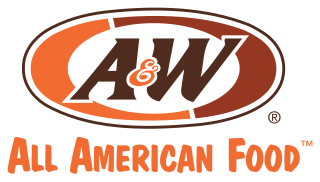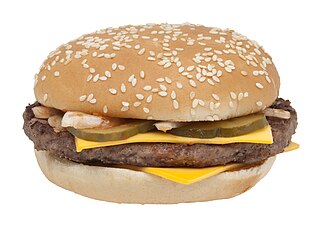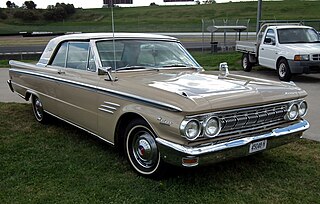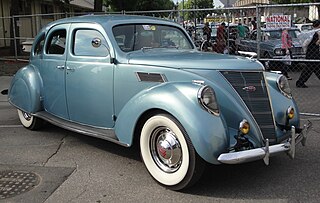
Edsel is a discontinued division and brand of automobiles that was produced by the Ford Motor Company in the 1958 to 1960 model years. Deriving its name from Edsel Ford, son of company founder Henry Ford, Edsels were developed in an effort to give Ford a fourth brand to gain additional market share from Chrysler and General Motors. Established as an expansion of the Lincoln–Mercury Division to three brands, re-christened the Mercury–Edsel–Lincoln Division, Edsel shared a price range with Mercury. The division shared its bodies with both Mercury and Ford.

Mercury was a brand of medium-priced automobiles that was produced by American manufacturer Ford Motor Company between the 1939 and 2011 motor years. Created by Edsel Ford in 1938, Mercury was established to bridge the gap between the Ford and Lincoln model lines within Ford Motor Company. From 1945 until its closure, it formed half of the Lincoln-Mercury Division of the company.

A&W Restaurants, Inc. is an American fast food restaurant chain distinguished by its "Burger Family" combos, draft root beer and root beer floats. A&W's origins date back to 1919 when Roy W. Allen set up a roadside drink stand to offer a new thick and creamy drink, root beer, at a parade honoring returning World War I veterans in Lodi, California. Allen's employee Frank Wright partnered with him in 1922 and they founded their first A&W restaurant in Sacramento, California in 1923. The company name was taken from the initials of their last names – Allen and Wright. The company became famous in the United States for its "frosty mugs" – the mugs were kept in a freezer and filled with A&W Root Beer just before being served to customers.

The Continental Mark II is an ultra-luxury coupé that was sold by the Continental Division of Ford for the 1956 and 1957 model years. The first product line of Continental, the Mark II was developed as the worldwide flagship vehicle of Ford Motor Company. Developed as a successor for the 1939–1948 Lincoln Continental, the Mark II derived its nameplate from European manufacturing practice, denoting a second generation of the model family; Ford would later use this nomenclature for the Mark Series of flagship personal luxury cars.
The Arch Deluxe was a hamburger sold by the international fast food restaurant chain McDonald's in 1996 and marketed specifically to adults. Despite having the largest advertising and promotional budget in fast food history at the time, it was soon discontinued after failing to become popular. It is considered one of the most expensive product flops of all time.

The Lincoln Versailles is a mid-size luxury car that was marketed by Lincoln from the 1977 to 1980 model years. The first Lincoln introduced outside of the full-size segment, the Versailles is a rebranded version of the Ford Granada and Mercury Monarch. Replacing the Mercury Grand Monarch Ghia, the model line was introduced as a competitor to the Cadillac Seville.

The Mercury Montclair is a series of full-size sedans that were manufactured and marketed over five generations by the Mercury division of Ford. The nameplate was used by the division twice, from the 1955 to the 1960 model years and from the 1964 to the 1968 model years. The model was offered as two-door and four-door hardtops, four-door pillared sedan, and a two-door convertible.

The Quarter Pounder is a brand of hamburger introduced in 1971 by a Fremont, California franchisee of international fast food chain McDonald's and extended nationwide in 1973. Its name refers to the beef patty having a precooked weight of approximately one quarter of a pound, originally portioned as four ounces (113.4 g) but increased to 4.25 oz (120 g) in 2015. In some countries where the pound is not customarily used as a unit of weight, the hamburger's branding instead features the word Royal.

The Mercury Meteor is an automobile that was produced by Mercury from the 1961 to 1963 model years. Adopting its nameplate from the namesake Ford of Canada brand, the Meteor was introduced as the base-trim full-size Mercury sedan, while the compact Mercury Comet shared a naming convention associated with the ongoing Space Race of the early 1960s. Slotted below the Mercury Monterey, the Meteor was the Mercury counterpart of the Ford Fairlane.
Louis Cheskin was a scientific researcher, clinical psychologist, and marketing innovator. Born in the Russian Empire on February 17, 1907, he was a one-time Works Progress Administration (WPA) artistic supervisor. He died of a heart attack at Stanford University Hospital on October 10, 1981, at age 72.

The Edsel Corsair is an automobile that was produced and sold by Edsel in 1958 and 1959. For 1958, the Corsair was built on the longer, wider Edsel platform shared with Mercury. For 1959, the Corsair shared the shorter, narrower Ranger platform with Ford.

The Edsel Bermuda is a station wagon that was produced and sold by Edsel in 1958. Like the Edsel Villager and Edsel Roundup station wagons, the Bermuda was built on a 116-inch (2,946 mm) wheelbase shared with Ford's station wagons, as well as core body stampings.

The Edsel Ranger is an automobile that was produced and sold by the newly formed Edsel Division of Ford for the 1958–1960 model years. It was built on the shorter, narrower Edsel platform, shared with Ford and Edsel Pacer models.

Brewster & Company was an American custom carriage and motorcar coachbuilder. James Brewster established the company in 1810 which operated for approximately 130 years. Brewster got its start in New Haven, Connecticut, and quickly gained a reputation for producing the best carriages in the country. In 1827, he set his shop at 52 Broad Street in New York City.

The Mercury Eight is an automobile that was produced by the American manufacturer Ford Motor Company under their now defunct division Mercury between 1939 and 1951. The debut model line of the Mercury division, Ford positioned the full-size Mercury Eight between the Ford Deluxe model lines and the Lincoln. In total, Ford assembled three generations of the Eight.

The Lincoln-Zephyr is a line of luxury cars that was produced by the Lincoln division of Ford from 1936 until 1942. Bridging the gap between the Ford V8 DeLuxe and the Lincoln Model K, it expanded Lincoln to a second model line, competing against the Chrysler Airflow, LaSalle, and the Packard One-Twenty.

The Lincoln L series is the first automobile that was produced by the Lincoln Motor Company. Introduced in 1920, the L series would continue to be produced after the bankruptcy of Lincoln in 1922 and its purchase by Ford Motor Company.

The Mercury Marauder is an automobile nameplate that was used for three distinct full-size cars produced by the Mercury division of Ford Motor Company. Deriving its name from the most powerful engines available to the Mercury line, the Marauder was marketed as the highest-performance version of the full-size product range.
Joseph E. Cappy is an American business executive who was the final president and chief executive officer of American Motors Corporation and the first president and CEO of the Dollar Thrifty Automotive Group.
The third-pound burger is a hamburger made with a patty that weighs one-third of a pound before cooking. It is larger than the more common quarter-pound burger typically sold by fast-food chains. The third-pound burger gained notable attention in the 1980s due to an ill-fated marketing campaign by A&W Restaurants in the United States, which has since become a case study in consumer behavior and market communication.
















